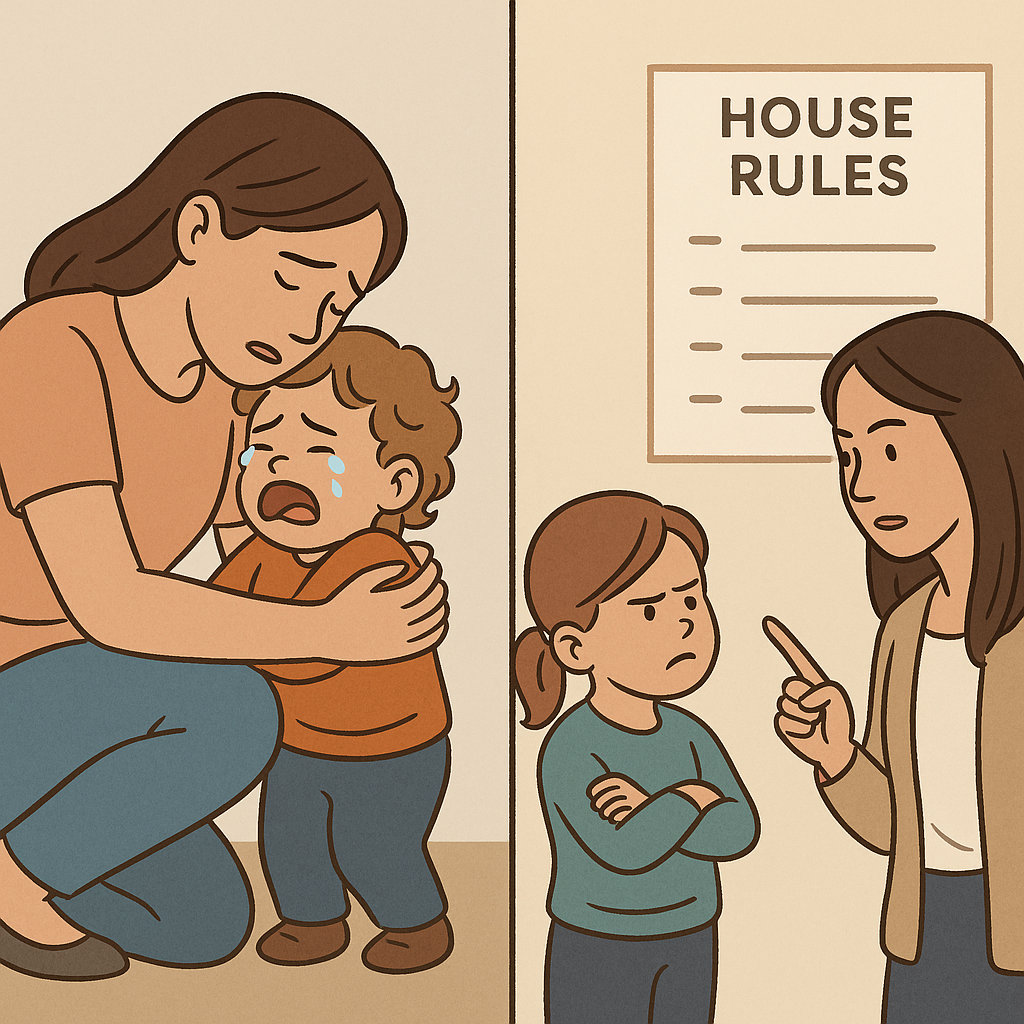Introduction
Parenting today comes with countless buzzwords and advice. Two approaches drawing the most attention are gentle parenting and authoritative parenting. In fact, gentle vs authoritative parenting styles is one of the most debated topics among parents and experts. Social media is filled with posts about “gentle parenting,” highlighting interest in this empathetic approach. Meanwhile, researchers praise authoritative parenting as the “gold standard” for raising well-adjusted kids. But what do these terms really mean, and how do they compare? This article explores gentle vs authoritative parenting styles—defining each, highlighting differences and similarities, and sharing expert insights. The goal is to give moms (and dads) useful parenting knowledge to make smart choices in everyday mommy life. In the end, you’ll see why blending both approaches often creates the best balance for raising happy, confident children.

What is Gentle Parenting?
Gentle parenting is a child-centered parenting style that emphasizes empathy, respect, and understanding. In practice, this means parents focus on nurturing a strong bond and guiding behavior through positive methods rather than punitive discipline. Key principles of gentle parenting include:
- Empathy and Respect: Parents treat children as individuals with valid feelings and perspectives. A gentle parent tries to see situations through the child’s eyes and respond with compassion.
- Positive Discipline: Rather than yelling or harsh punishment, gentle parenting uses positive parenting solutions like clear boundaries, explanation of rules, and natural consequences. For example, instead of immediate time-outs for misbehavior, a gentle approach might involve calmly explaining why the behavior is harmful and suggesting a better choice[2].
- Emotional Validation: All emotions—big or small—are acknowledged. If a child is angry or upset, gentle parents allow the feelings, help the child name them, and provide comfort while still enforcing necessary limits.
Research suggests that gentle parenting can reduce child anxiety [3] and improve emotional intelligence [3]. Importantly, gentle doesn’t mean permissive. Parents still set boundaries; they simply enforce them with patience, not harshness [9]. This style is often compared in discussions of gentle vs authoritative parenting styles, since both emphasize warmth and connection while differing in structure [9].
Real-world example: Imagine a 3-year-old throws a toy in anger. A gentle parent would get down to the child’s level, acknowledge their frustration (“I see you’re upset”), explain calmly that throwing toys can hurt someone or break the toy, and guide the child toward a better action (“Let’s find a safe way to show you’re mad, like using words or taking a deep breath”). The child may still get a consequence (like temporarily losing the toy), but it’s delivered with explanation and warmth. The emphasis is on teaching rather than punishment.

What is Authoritative Parenting?
Authoritative parenting is often described as a balanced, “firm but loving” approach to raising kids. Developmental psychologists define authoritative parents as high in both responsiveness and demandingness – meaning they show lots of warmth and support and enforce clear rules and expectations[5][6]. This style is sometimes called the “sweet spot” of parenting styles, in contrast to the extremes of authoritarian (too strict) or permissive (too lenient).
Hallmarks of the authoritative parenting style include:
- Clear Boundaries: Authoritative parents set clear rules and consistent limits. Children know what behavior is expected and what the consequences are if rules are broken.
- Warmth and Support: Even while enforcing rules, these parents are highly responsive to their child’s needs and feelings. There’s an atmosphere of love, open communication, and mutual respect. Kids feel heard and supported.
- Discipline with Teaching: Discipline isn’t about control or punishment for its own sake, but about teaching life lessons. Consequences are fair and often explained. For example, instead of “Because I said so,” an authoritative parent will explain the reason behind a rule, helping the child understand why certain behaviors are required.
- Encouraging Independence: Children are given age-appropriate freedom and choices. Authoritative parents guide their kids to make good decisions, solve problems, and learn self-regulation, rather than micromanaging every move.
Notably, authoritative parenting has a strong track record in research. Numerous studies (and organizations like the American Academy of Pediatrics) recommend the authoritative style for its positive outcomes. Children of authoritative parents tend to grow into independent, self-reliant, and socially competent individuals[7][8]. This style has been linked to higher self-esteem, better academic performance, and good mental health in kids and teens[9]. It’s considered a “smart parenting” approach because it balances love and discipline effectively.
To illustrate, consider a scenario with a 10-year-old who procrastinates on homework. An authoritarian parent might demand completion with threats, while a permissive parent might do nothing. An authoritative parent, however, would set a rule (homework before screen time), explain why homework matters, and follow through with consequences if the child neglects it (e.g., losing some video game time) – all while offering help or encouragement as needed. The child learns responsibility and time management, but also knows that their parent cares and will listen to their feelings (maybe the assignment is hard or they feel tired, which the parent will empathize with without removing the expectation).

Understanding your parenting style starts with self-awareness. Many parents find it helpful to reflect on their daily habits and values to see where they naturally fall on the gentle–authoritative spectrum. Tools like a Parenting Style Self-Assessment Workbook or guided parenting journal [Affiliate Link] can make this easier by helping you identify strengths, triggers, and growth areas.
Key Differences Between Gentle and Authoritative Parenting
While similar, the two styles differ in emphasis, and understanding these distinctions is essential when comparing gentle vs authoritative parenting styles.
1. Approach to Discipline: The biggest perceived difference is in disciplinary tactics. Gentle parenting explicitly avoids harsh punishments and even traditional timeout strategies. Discipline is more collaborative – for instance, using natural consequences or problem-solving together with the child. A gentle parent might say, “How can we fix this?” and guide the child to reflect on misbehavior. In contrast, authoritative parenting definitely uses consequences and sometimes structured techniques like a timeout or loss of privileges, but in a measured way. The key is that authoritative discipline is firm but fair – rules are non-negotiable, yet the method isn’t mean or arbitrary. You can think of it this way: gentle parenting leans a bit more toward soft guidance, whereas authoritative parenting incorporates clear authority. Both reject yelling or spanking; they just implement discipline along a spectrum from very collaborative (gentle) to moderately structured (authoritative).
Example: If a young child hits their sibling, a gentle parent might kneel, discuss feelings, and encourage the child to apologize and find a kind alternative action (with the parent’s help). An authoritative parent will similarly address the behavior immediately, firmly tell the child “Hitting is not OK,” enforce an age-appropriate consequence (like a brief timeout or losing a privilege), and then talk about better choices and have the child apologize. The gentle approach spends a bit more time on the child’s emotional process in the moment; the authoritative approach spends a bit more time on the rule and consequence while still being kind.
2. Emotional Communication: Both gentle and authoritative parenting styles value emotional connection—but they express it in slightly different ways. Gentle parenting focuses more on child-led emotion coaching, while authoritative parenting blends empathy with gentle correction. Creating a calm environment makes a big difference here. Simple tools like a Calm-Down Corner Kit with sensory items or emotion flashcards [Affiliate Links] help children learn to self-regulate through play.
3. Flexibility vs. Structure: Gentle parenting is sometimes viewed as more flexible or “child-directed.” If a child strongly resists a certain routine (say, a toddler refusing bedtime), a gentle parent might adapt the approach – perhaps delaying bedtime slightly or finding a gentler transition – prioritizing the child’s comfort level. Authoritative parents value structure and might be more inclined to hold the limit (“Bedtime is 8 PM”) firmly, while still being caring (maybe adding an extra hug or a quick story to ease the child in). In effect, authoritative style emphasizes consistency in routines and expectations, whereas gentle style might allow more wiggle room if a routine is causing distress, so long as the child eventually complies.
It’s important to note that these differences are often about tone and timing rather than totally different outcomes. A gentle and an authoritative parent likely both expect the child to go to bed – the gentle parent might spend 15 extra minutes negotiating it calmly, while the authoritative parent might enforce it promptly with a kind but no-nonsense approach. Neither style is permissive (where the parent would give up and let the child stay up indefinitely).

4. Philosophy and Identity: Many parents see gentle parenting as a philosophy about honoring a child’s voice. It’s often presented in blogs, groups, and social media as a lifestyle built on gentleness and mindfulness. Authoritative parenting, by contrast, comes from decades of psychological research (originating with Diana Baumrind in the 1960s) and is usually a researcher’s category rather than a parent’s chosen identity. In practice, much of today’s positive parenting advice, including programs like Positive Parenting Solutions, reflects authoritative principles under a modern label. Some experts note that what many moms online call gentle parenting is essentially authoritative parenting expressed in newer language [11]. The takeaway: gentle parenting is a popular, modern form of authoritative parenting. Both aim to be firm and loving, but gentle parenting culture places extra focus on avoiding authoritarian methods like yelling or punitive timeouts.
How Are Gentle and Authoritative Parenting Similar?
Despite the nuanced differences above, it’s crucial to realize that gentle and authoritative parenting have far more in common than not. Experts often consider gentle parenting to be a subset of authoritative parenting because the overlap is so strong, reinforcing that gentle vs authoritative parenting styles share more common ground than differences.
- High Warmth and Nurture: Both styles involve being highly responsive to children’s needs. Parents using either approach give plenty of affection, attention, and support. The child’s emotional well-being is a top priority in both gentle and authoritative homes.
- Firm (but Fair) Boundaries: Being firm, fair, and friendly helps children understand what’s expected while still feeling supported. Consistency builds trust—and structure keeps chaos away. Using visual aids like a Family Routine Planner Board, visual timer, or magnetic chore chart [Affiliate Links] can make routines easier for kids to follow and reinforce positive behavior.
- Respectful Communication: Yelling, threatening, shaming – these tactics are avoided in both styles. Instead, communication is respectful and age-appropriate. Authoritative and gentle parents both explain rules and decisions to their kids, listen to the child’s viewpoint, and encourage a two-way dialogue. Children are allowed to ask questions or express feelings about rules.
- Focus on Teaching Skills: Ultimately, both approaches share the goal of teaching children life skills and values. Whether it’s called gentle or authoritative, the parent is working to raise a child who is empathetic, confident, self-regulated, and responsible. There’s a long-term focus: today’s discipline moment is viewed as an opportunity to help the child learn a valuable skill (such as patience, honesty, or how to calm down) that will benefit them later in life. This is very different from an authoritarian “just obey me” mindset or a permissive “do whatever you want” approach. In essence, gentle and authoritative parenting both aim to raise kids with positive life skills and strong character.
It’s no surprise, then, that studies find little ones thrive when parents are both warm and firm. As one clinical psychologist notes, children do best when caregivers provide “safe, stable, and nurturing” relationships combined with “consistent expectations and guidance”[13]—which is exactly what both gentle and authoritative parenting strive to do. Supporters of gentle parenting often clarify that it’s not about eliminating discipline, but about enforcing discipline in a kind way[14]. That philosophy is perfectly in line with authoritative parenting. In fact, many parenting books and programs blur the line between the two terms. For example, the popular author Sarah Ockwell-Smith, who helped popularize “gentle parenting,” describes techniques (like validating feelings, setting limits with empathy, etc.) that are essentially the same tools an authoritative parent would use[11].
Bottom line: Gentle parenting and authoritative parenting both fall in the healthy middle ground of parenting styles. They reject the extremes of harshness or neglect, finding a balance that is both loving and appropriately strict. Any differences are often about personal style or the child’s temperament, rather than one approach being “good” and the other “bad.” Both aim to raise confident, well-behaved kids—just with slightly different flavors.

Why a Mix of Both Styles Is Often Best
If gentle and authoritative parenting are so alike, does a parent need to choose one? According to most experts, not at all. In fact, the smart parenting approach for many families is to blend the best of gentle and authoritative techniques. Real-life parenting rarely fits one style; experts recommend blending gentle vs authoritative parenting styles for balance. A flexible parent can toggle between a gentler style and a more authoritative stance as needed.
Modern child psychologists often encourage parents to attune themselves to their child’s temperament and context. As one article noted, “every child is different, and a good parent is attentive and acts accordingly when a different parenting approach better suits their child’s current needs.”[8]. In practice, this means sometimes a very gentle approach is appropriate (e.g., with a highly sensitive child who responds poorly to any strictness, or during a moment when a child is very fragile and just needs comfort). Other times, a more authoritative approach is needed when a child tests limits and requires clear, consistent boundaries. The ability to use both gentle and authoritative strategies gives parents a wider toolset. It’s like using two styles: emphasize empathy when needed, or add structure and firmness when necessary.
In reality, gentle and authoritative methods complement each other more than they conflict. For example, be gentle in tone—soft voice, validating feelings—while authoritative in action by upholding rules. If your toddler tantrums about leaving, gently acknowledge feelings while still buckling them in to go. That’s a perfect mix: the child feels heard and loved (gentle), but the boundary is non-negotiable (authoritative). In this way, combining the styles shows kids that parents care for them while still expecting appropriate behavior.
Experts also stress that avoiding extremes is key. Being too lenient, or overly permissive, can cause kids to lack discipline and respect for others’ needs. On the flip side, being too strict (authoritarian rather than authoritative) can cause anxiety or rebellion. A blend guards against either extreme. CNBC interviewed parenting experts who concluded that gentle and authoritative strategies working together can be very effective – parents don’t have to adopt a one-size-fits-all label[7][8]. The ultimate goal is to raise kids who have both emotional security and good behavior, and a hybrid gentle-authoritative approach can do just that.
Think of it like gardening: gentle parenting provides sunlight and water, while authoritative parenting is the supportive stake. A plant benefits from both nourishment and guidance. Too much water makes it weak; too much stake makes it brittle—kids need both nurture and structure. The right balance lets the child flourish, with deep roots of trust and strong branches of discipline.

The Research and Expert Consensus
It’s worth noting that decades of research point to authoritative parenting (again, defined by warmth + structure) as yielding the best overall outcomes for children[15]. Gentle parenting, as a variant of this, shares in those positive outcomes. Studies have linked these parenting practices to kids developing better self-regulation, social skills, and mental health. For example, one study cited by the American Academy of Pediatrics found authoritative parenting strongly associated with positive behavior and good mental health in children[9]. On the gentle side, research has indicated that using high-empathy, low-punitiveness approaches can make children less anxious and more independent[16]. These findings reinforce that being kind and firm at the same time is a winning combination.
Experts caution that parenting styles must adjust as children grow or when one approach fails; the best parents stay adaptive. Begin gently in toddler years to build attachment, then add rules and responsibilities as kids mature. Good parenting is a journey of learning and tweaking strategies. The common thread is maintaining both love and leadership.
As a parenting resource from The Pillars Christian Learning Center wisely put it, “That’s what smart parenting is all about – teaching children the skills they need for their future by enabling them to make their own smart choices. Our role as parents is to guide our kids along the way, rather than attempting to control their every move.”[17]. In essence, smart parenting—and smart mommy life—means using positive solutions from both gentle and authoritative styles. Guide, don’t control. Discipline, don’t punish. Listen, but don’t capitulate. This balanced mindset will help children develop life skills and confidence.
Conclusion
Both gentle parenting and authoritative parenting aim to raise resilient, well-loved kids who understand boundaries. Experts view gentle parenting as a modern, specialized form of the authoritative style, not its opposite.. Gentle parenting brings extra mindfulness and empathy; authoritative parenting brings proven structure and clarity. Combining both is often the ideal formula.
No two families are exactly alike, so the “right” mix of gentle and authoritative will vary. Some children might thrive with a very gentle touch; others need a bit more firmness. By educating yourself on these approaches (increasing your parenting knowledge), you can make informed choices tailored to your child. It’s not about choosing one camp or label, but about understanding the tools available.
In everyday parenting (the true test of mommy life!), you’ll likely find some days you lean gentle, other days you lean authoritative – and that’s okay. What matters is that your child consistently experiences love, support, and clear guidance. If you maintain empathy in your connection and consistency in your expectations, you are hitting that smart parenting sweet spot.
Research and experience both show that blending gentle and authoritative parenting fosters confidence, empathy, and resilience in kids. If you’re looking to build on these principles, resources like Positive Parenting Solutions Online Courses [Affiliate Link] or best-selling parenting books offer practical strategies you can start using today.

Affiliate Recommendation: Looking for practical guidance on positive discipline techniques? Consider resources like “Positive Discipline: The Classic Guide to Parenting” by Jane Nelsen or “The Whole-Brain Child” by Siegel & Bryson for expert-backed tips (Amazon affiliate link placeholders). These materials dive deeper into blending warmth with structure, helping parents implement gentle and authoritative strategies effectively in daily life.
FAQ
Q: Is gentle parenting the same as authoritative parenting?
A: They are closely related. Gentle parenting is essentially a form of authoritative parenting that places extra emphasis on empathy and non-punitive discipline. Both involve being nurturing and setting firm boundaries. In fact, psychologists classify gentle parenting under the authoritative style[4]. The slight difference is that gentle parenting tends to be more child-led (especially regarding emotions), but in terms of core principles—firm and kind— they are the same at heart.
Q: How is gentle parenting different from permissive parenting?
A: Gentle parenting is not permissive. Permissive parents set few rules and often give in to avoid conflict, which can leave kids without guidance. Gentle parents, by contrast, do have rules and expectations, but they enforce them in a calm, compassionate way. For example, a permissive parent might not discipline a child for drawing on the walls at all; a gentle parent will address it without yelling—perhaps helping the child clean the wall and talking about why that behavior is not okay. The key difference is that gentle parenting still holds children accountable (making it closer to authoritative), whereas permissive parenting largely lets kids “rule the roost.”
Q: What are the benefits of an authoritative parenting style?
A: Research consistently links authoritative parenting to many positive outcomes for kids. Studies find that children raised with a balance of warmth and structure tend to develop better self-discipline, higher self-esteem, and stronger social skills[18][7]. They are often more independent and do well in school. Because authoritative parents provide love and clear guidance, kids learn to regulate their behavior and emotions in a healthy way. Major health and psychology organizations often recommend authoritative-style techniques as an effective way to raise confident, resilient children.
Q: Can I mix gentle parenting with other styles?
A: Yes, parenting is not one-size-fits-all. You can absolutely use gentle parenting techniques alongside other positive strategies. In practice, gentle and authoritative approaches mix very well (as discussed above). Some parents also incorporate ideas from attachment parenting in infancy or positive parenting programs as the child grows – many of these overlap with gentle/authoritative principles anyway. The important thing is to remain consistent in being loving but firm. It’s also wise to avoid mixing in any authoritarian (harsh, punitive) methods with gentle parenting, as that can be confusing for a child and undermine trust. Sticking to a gentle/authoritative blend – sometimes being more flexible, sometimes more structured – is a sensible strategy.
Q: What if gentle parenting isn’t “working” for my child?
A: A purely gentle approach may feel ineffective if a child keeps testing limits. In that case, add authoritative elements such as consistent consequences, routines, and clear rules. Gentle doesn’t mean losing authority—you can be empathetic and still firmly say “no.” Children often feel more secure when parents consistently enforce boundaries. Every child is different: some need more empathy, others more structure. Adjust the balance as needed, and if necessary, seek guidance from a parenting coach or psychologist. The goal isn’t rigid loyalty to one philosophy, but finding what helps your child thrive in a loving, supportive relationship.
[1] Gentle Parenting: Myths, Techniques, and Benefits for Raising Emotionally Healthy Children – TPR Teaching
[2] [3] [9] [10] [15] Gentle Parenting vs Authoritative Parenting: Key Differences and Benefits – Parent Classes Online
[4] [5] [12] [13] Gentle Parenting Doesn’t Mean Permissive Parenting | Psychology Today
[6] [11] [14] [18] 11 Different Types of Parenting Styles and How They Affect Kids
[7] [8] [16] ‘Gentle Parenting’ Isn’t Impossible, Here’s How To Mommy Softly
Lisa
